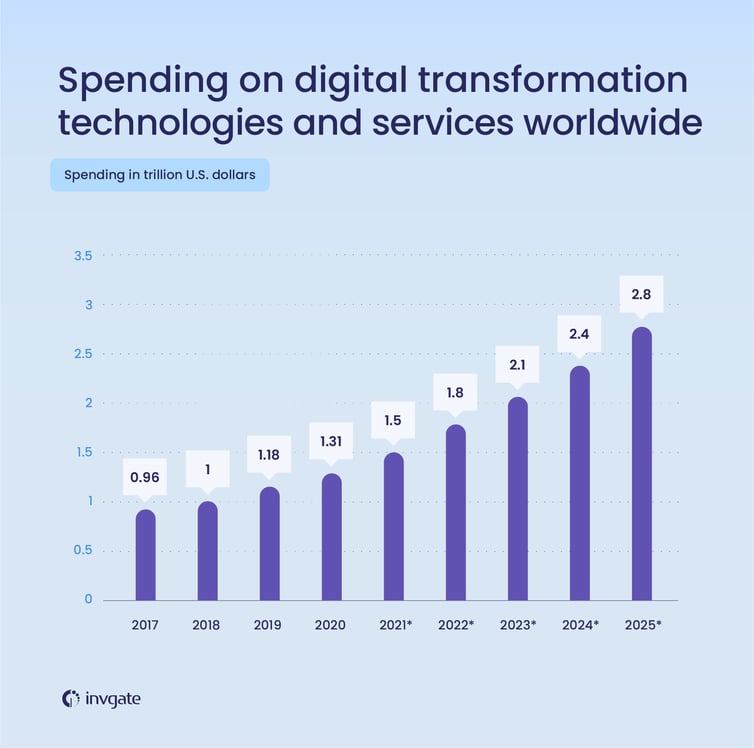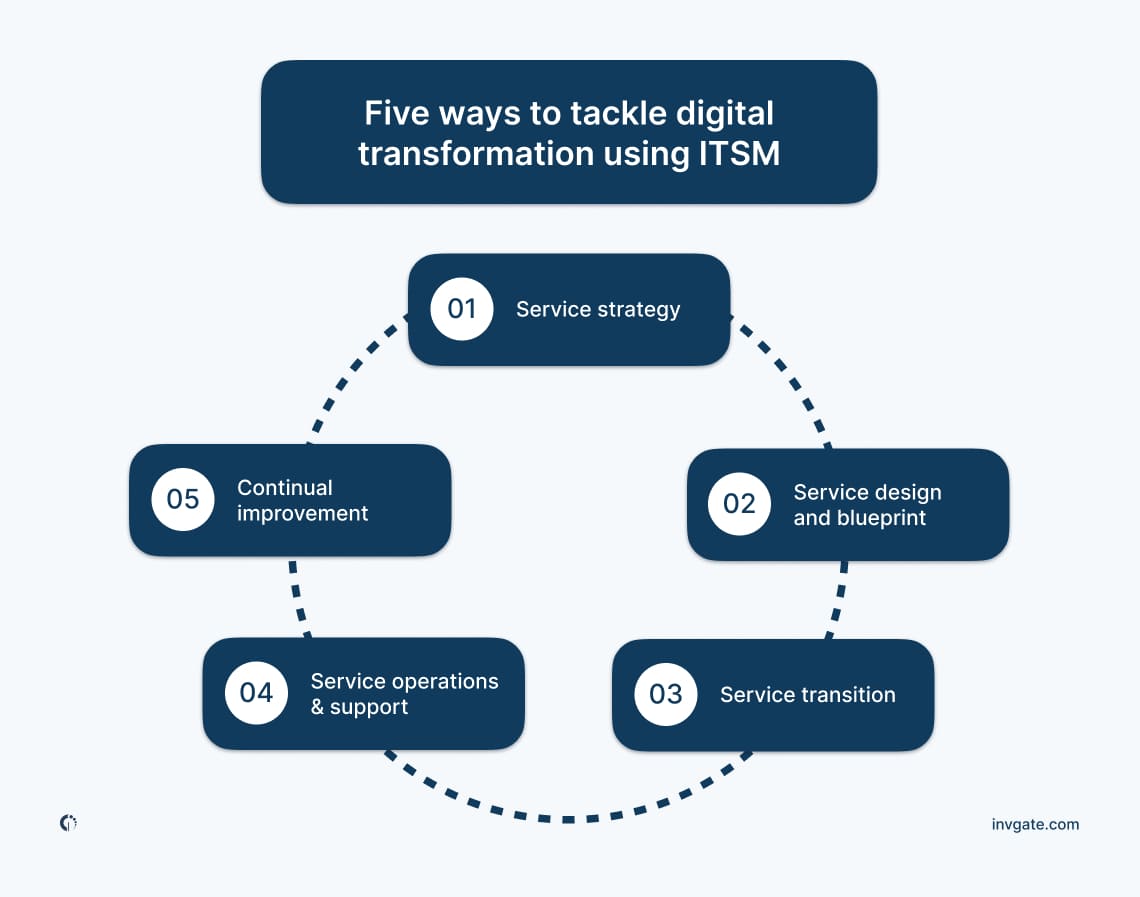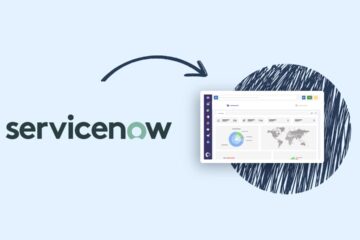IT Service Management (ITSM) is a fundamental piece in your digital transformation puzzle. In short, it provides a structured approach to managing digital services, ensuring they align with your organization’s digital transformation goals.
When embarking on such a journey, you will be leveraging different technologies to improve and optimize business processes, enhance customer experiences, and drive overall organizational efficiency.
To support this digital transformation, an ITSM strategy will help you design and maintain IT processes, services, and outcomes across your organization. Also, incorporating a robust ITSM tool will make your IT service delivery leaner and more effective, setting the scene for continuous improvement.
Are you ready to learn how ITSM can support your digital transformation efforts? Let’s dive in.
What is the role of ITSM in digital transformation?
Digital transformation is not a small undertaking. The clue is in the name! It involves transforming your organization and its ways of working, replacing manual, paper-based tasks with new technology to deliver better outcomes to customers and stakeholders.
Of course, an initiative of that scale needs support. Between using new tools, implementing new technology, and satisfying customer needs at the same time, it’s important to ensure that this multi-layered process is executed in the right way. This is where ITSM comes into play.
A robust ITSM strategy is a must for your digital transformation initiative as it will guarantee the organization’s IT infrastructure is up and running and that technical difficulties are resolved effectively and on time. Also, it will make sure you are offering a great experience for users who are incorporating new digital tools and work processes.
Here are some of the main ways IT Service Management can help you on your digital transformation journey:
- By designing your IT services in a structured and organized way (in a service catalog, for instance) they will be available when needed, perform in line with business goals, and meet regulatory and legal requirements, ensuring that IT teams are held accountable for service delivery and that end-users get the help they need.
- Along with the previous point, a solid IT support offering guarantees that any issues that come up can be easily reported on and fixed quickly without adversely impacting business operations.
- Knowledge Management initiative provides your team with thorough resources and training to help them understand the new technology and ways of working. This can come in many forms, such as a central knowledge base with articles, how-to’s, and videos.
- Change Management/Enablement and Release Management practices in ITSM ensure that any new tools and services are transitioned effectively, efficiently, and safely. It provides a structured and efficient way to handle changes required to improve IT services, business operations, and outcomes, and ultimately customer experience.
- Configuration Management to ensure the new services and any dependencies are understood, particularly in relation to links into legacy systems.
- The continual improvement practice will help your IT Management grow, evolve, and adapt. The digital scenario is constantly on the move, so it’s important to guarantee that your new ways of working will stay aligned with the new trends and business goals.
To help with this process, a service desk solution is a must-have. It provides a centralized platform for streamlining IT service delivery and automating processes, enabling organizations to adapt to evolving technology landscapes while optimizing operational efficiency. But more on this later, we promise.

Benefits of using ITSM to support digital transformation
To delve a little deeper into the topic, here are some of the key benefits leveraging ITSM practices and processes will bring to your digital transformation approach:
- Stronger operational efficiency – By streamlining and optimizing IT Management and automating routine tasks, you will reduce operational bottlenecks and improve overall efficiency.
- More accurate, repeatable processes – Standardized processes ensure consistency and accuracy in the delivery of IT services and a more reliable and predictable IT environment.
- Improved transparency – The practice provides visibility into IT processes, workflows, and service performance, enhancing transparency across the organization and fostering better decision-making.
- Better management of complexity – ITSM frameworks provide a structured approach to managing the complexity of IT environments. Through well-defined processes and documentation, this helps organizations navigate and control the complexities associated with digital transformation.
- Enhanced Customer Experience (CX) – ITSM’s customer-centric approach aligns IT with customer needs and expectations. Also, improved incident resolution times and self-service options enhance the overall experience.
- Reduced costs – By identifying and addressing inefficiencies, the practice helps reduce operational costs and optimize your IT budget. On top of this, automation and standardized processes contribute to cost savings through increased productivity.
Five ways to tackle digital transformation using ITSM

In short, IT Service Management practices centralize and streamline IT service offerings, helping organizations navigate the complexities of modern technology landscapes and digital transformation journeys while keeping the customer at the center.
To help you with this initiative, the following five steps bring together key ITSM processes that will equip you to tackle digital transformation.
1. Service strategy
Service strategy is a group of ITSM practices that creates the overall approach for IT services.
The purpose of this stage is to establish the perspective, position, plans, and patterns necessary for a service provider to achieve an organization’s business outcomes. Developing a strategy ensures that IT and the business collaborate to create a strong foundation and approach for designing, building, and enhancing effective and efficient IT services. Key practices at this stage include Strategy Management for IT services, IT Financial Management, Demand Management, Service Portfolio Management, and Business Relationship Management. These practices help align digital transformation goals with business objectives, manage finances effectively, understand demand for new services, oversee service portfolios, and foster strong relationships within the organization. Ensuring that new products and services developed through digital transformation initiatives continuously evolve and improve is crucial for meeting business needs and adding value over time. In a dynamic digital landscape, it is essential to keep your IT service delivery up-to-date with the latest work methods.
When it comes to digital transformation, implementing an ITSM solution plays a vital role in the process. InvGate Service Desk offers an intuitive user experience for managing IT support, making it ideal for onboarding new users and ensuring smooth adoption during your digital transformation journey. The tool is highly scalable to accommodate your company’s growth and changing requirements.
In addition to its user-friendly interface, InvGate Service Desk provides features like a self-service portal for users to submit requests and track them, automated workflows for structured processes, AI-powered capabilities for improved efficiency, customized dashboards for monitoring performance, and support for Enterprise Service Management (ESM) expansion.
To summarize, digital transformation involves integrating technologies to drive significant change and enhance service delivery. ITSM plays a crucial role in supporting this transformation by ensuring safe transition of new services, knowledge retention, and effective support models. Consider trying out InvGate Service Desk’s 30-day free trial to experience how the tool can enhance your digital initiatives seamlessly on your WordPress platform. sentence: The cat sat lazily in the sun.
Rewritten sentence: Lazily, the cat sat in the sun.



